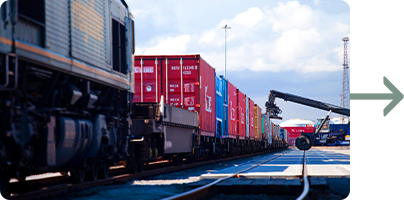Unique Logistics Solutions to Complex Container Drayage Issues
Today, more than 80% of global shipping involves containers. They're packed with everything from personal storage items in dry containers to heavy machinery on flat rack containers. For business owners shipping products, getting a container from point A to point B requires precise planning and high-level tracking. But that's easier said than done when global supply chains become over-congested, leading to loading time issues and delays.
That's bad news for business owners who are already under a massive amount of stress. The truth is that container storage delays can cripple a business, but there's a viable solution: drayage brokers in Charleston, SC like RelyEx. Drayage companies provide unique solutions to minimize demurrage and help ensure the successful delivery of your freight.
With more than 30 combined years of experience and a solutions-oriented team, RelyEx has quickly become the first choice for streamlined, efficient drayage services. To understand the true value of RelyEx's offerings in the global logistics industry, it helps to understand first what drayage is and why it's used.
What is Drayage and Why Is It Important?
If you're a seasoned business owner who uses port drayage to transport your products, you know exactly how important the service can be. But if you were to poll a group of random people, you may get five different definitions of the term "drayage." That begs the question, how is one of the most crucial steps in the supply chain and most vital components of global trade such a confusing concept? When you break it down, it's not too difficult to grasp.
Drayage, by definition, means the transportation of freight from an ocean port to another destination. Today, drayage is also used to describe the process of transporting products and goods over short distances or over "the first mile."
While drayage often means short-distance movements during the supply chain process, it's primarily used in the container shipping space. Drayage loads usually have arrival and departure points in the same city and don't include long-haul, national transportation.
Let us know how we can help.
drayage broker Services
Service Areas
Because a drayage load can mean a few different things, confusion among carriers is common. Many carriers link drayage with going into a port, but that isn't always true. While all drayage loads typically originate from a port of entry, there are often several legs of a drayage journey before a container turns up at its final stop. Legs of a drayage load may include:
Why Are Drayage Companies in Charleston, SC So Important?
You may be thinking, what's so important about drayage? It's such a small step in the container storage transport process. In reality, it's an integral piece needed in the logistics industry and a crucial part of U.S. supply chain management.
To truly understand the importance of drayage, let's use flowers as an example. Most cut flower shipments enter the market from areas in South America until they end up at Dutch auction houses. Once there, wholesalers purchase flowers in bulk and send those products to retail outlets worldwide. Because flowers are perishable, they typically need to be refrigerated and are often shipped in reefer containers. These refrigerated vessels must maintain a certain temp to prevent loss.
Drayage companies like RelyEx allow flower shippers to send their products from Argentinian ports to airports in the Netherlands with peace of mind because their products are protected. The only way to accomplish this feat is with the help of swift, meticulous port drayage services. Drayage companies allow flower shippers to send their products from Argentinian ports to airports in the Netherlands with peace of mind, because their products are protected. The only way to accomplish this feat is with the help of swift, meticulous port drayage services.
If port drayage is compromised, it can cause delays and even fines. You know the packages you get delivered to your front door from apps like Amazon? Without drayage and drayage brokers, one or two-day shipping times wouldn't even be possible.
As a multi-billion-dollar industry in the U.S. alone, it seems like drayage shipping issues shouldn't exist. But the fact is inefficiencies and congestion are still major problems at ports. Whether it's a lack of carriers, absent chassis, or overburdened terminals, delays lead to missed deadlines, lost revenue, and worse.
But anytime challenges exist, so too do innovative solutions.
QUOTE REQUEST
Port

Yard

Warehouse

Rail

The RelyEx Difference
RelyEx was created because our founders saw a need in the logistics space for more reliability and efficiency. The reality of the shipping and logistics industry is that it has become very transactional. It's an odd evolution, because most businesses seek a third-party logistics partner that is accessible, transparent, and committed to providing solutions.
As the logistics space continues to grow, it creates newfound expenses and complexities. Clients like ours know that and need a supply chain partner who is genuinely interested in their business. By understanding the needs of our customers and carriers, we can provide the most reliable, effective drayage services possible.
Unlike some drayage companies in Charleston, SC, we begin managing your containers before they ever hit the ports by mapping out the most efficient pathways of delivery. That way, our team can discover the best drayage pathways to expedite delivery time and reduce fees that cut into profits.
Our valued drayage customers choose RelyEx because:

RelyEx Solves Problems
At RelyEx, we like to consider ourselves problem solvers. The nature of the container drayage industry presents new challenges every day, but we're firm believers that there's a solution to every hurdle we encounter. And while some drayage businesses implement a reactive approach, RelyEx customers choose us for our proactive mindset. We take pride in solving your company's drayage challenges to help you avoid frustrating fees, missed expectations, and delayed shipments. We strive to make every transaction successful and streamlined by partnering with shippers who prioritize transparent, prompt, and accurate communication.

RelyEx Has a Unique Vantage Point
RelyEx approaches your business from the customer's perspective - a unique approach that helps us provide high-quality, effective drayage services. We've been in the customers' shoes, know their pain points, and because of that, provide first-hand solutions to stressful supply chain issues. With over 30 years of collective knowledge, our team excels in:
- Inventory Management
- Logistics
- Purchasing
- Finance
Our varied, high-level drayage shipping experience helps us achieve our overarching goal: expertly managing your freight movement needs. That way, you can direct your time and focus on growing the core aspects of your business while we handle the heavy lifting. Throw in proactive planning to avoid bottleneck situations and strong communication for transparent customer relations, and you can see why so many companies trust RelyEx.

RelyEx Nurtures Strong Carrier Relationships
When it comes to shipping logistics, it only takes one mistake by a mediocre worker to disrupt your business. That's why, at RelyEx, we pride ourselves on forming and nurturing relationships with carriers who match our standards of care. Our founding partner started his career transporting freight for companies as an on-demand carrier. He uses that knowledge to maximize the resources of our carriers so that our customer's expectations aren't just met - they're exceeded.
Why Choose RelyEx as Your
Drayage Company in Charleston, SC?
Based in the port city of Charleston, RelyEx has a keen understanding of the challenges of managing the inbound and outbound flow of containers. Our team of container drayage experts provides your business with unique solutions to nuanced shipping problems, minimizing demurrage and ensuring the successful delivery of your freight.

Customers choose RelyEx because:
- We are a reliable drayage logistics partner that manages your freight from beginning to end
- We have a rare industry vantage point with 30+ years of client-side experience
- We foster and fortify the strongest vendor relations
- We take a proactive approach to problem-solving, not a reactive approach
Let us know how we can help.
 843-885-3082
843-885-3082

Your Drayage Shipments Managed from Start to Finish
Some drayage brokers don't care how customers feel about their service as long as they sign a contract and get paid. As a solutions-oriented team, RelyEx takes the opposite approach. We're motivated by the opportunity to overachieve for our customers and to provide them with the best logistics experience possible. With professional experience as carriers and shippers ourselves, we know the roadblocks and challenges you're facing. We excel at mapping out the best plans of action to solve those problems. But that's just the start.
Our tracking experts monitor and manage every aspect of your drayage shipment from booking to delivery, 24/7. Once booked, we look for the availability of your containers hourly once they're at port. When they arrive, our team acts quickly to access your storage containers when they're available.
Plus, RelyEx ensures your company's requirements are met by the carrier during loading and delivery and provide necessary documentation as fast as possible. With real-time tracking updates and access to our customer service professionals, your team has complete visibility throughout the shipping process.
We Source Top-Notch Operators at the Best Prices
Over the years, RelyEx has built a strong network of drayage carriers, transloading locations, and container storage spaces to provide you with the best possible options to match your drayage service needs. We know that searching for quality service presents an added layer of complexity and stress to our customers. That's why we work hard to take that off your plate by connecting you with our reliable shipping partners.
With a background moving freight as an on-demand carrier, our founding partner understands how to maximize the resources and equipment of our carriers to match your needs.


We Make Transparent, Timely Communication a Priority
Like other industries, the global logistics space is complex. Mistakes will be made, and problems will happen. With those truths in mind, RelyEx has built its reputation as problem solvers. Unlike other drayage companies, we don't shy away from this industry's complexities because we take pride in solving problems. Even better, we aim to do what's needed to avoid those problems altogether.
As your logistics partner, we will provide your company with accurate, transparent, and prompt communication. If there are unexpected issues, we'll notify you immediately and will provide several options to remedy the problem. We even offer custom reporting for large clients who need at-the-moment updates and quick access to shipment documentation.
We Have Robust Project Management Experience
Why let the unpredictability of your industry dictate your success? With a background working in manufacturing, our founders are familiar with the demands of managing production schedules and sales orders. That experience makes it abundantly clear to us that every business and industry is different. If you struggle with seasonal surges or other factors, our team supports your business with a mapped-out plan and schedule, so you stay ahead of the game.
QUOTE REQUEST
How to Avoid
Demurrage Fees for Your Business
Based in the port city of Charleston, RelyEx has a keen understanding of the challenges of managing the inbound and outbound flow of containers. Our team of container drayage experts provides your business with unique solutions to nuanced shipping problems, minimizing demurrage and ensuring the successful delivery of your freight.
What is shipping demurrage?
Demurrage is a charge issued by a port, carrier, or railroad company for storing containers that do not load and unload their cargo promptly. Once the daily limit of free time is exceeded, shippers are charged daily demurrage fees until their cargo is shipped. Though different ports have different policies, charges can range from $75 to $150 per container, per day, for a set number of days. Additional demurrage fees are incurred if a shipper exceeds the port's parameters.

What causes demurrage charges?
Even when shippers maintain a tight schedule for unloading freight, external factors can play an uncontrollable part. Typically, shipping mistakes caused by human error trigger the most demurrage charges. Some of the most common causes of demurrage include:
- Paperwork Errors
- Payment Delays
- Documents Received Too Late

Paperwork Errors
Typically, shippers need four specific documents to clear shipments through customs: A Bill of Lading (or BOL), a commercial invoice, a packing list, and an arrival notice. Seasoned drayage brokers like RelyEx are used to preparing these documents, but new shippers tend to miss this step due to inexperience.
Payment Delays
If a shipper only pays for part of their shipment, a vessel operator may refuse to release their freight until their bill is fully paid. Payment delays lead to cargo detention at the port of entry, which triggers demurrage charges.
QUOTE REQUESTDocuments Received Too Late
Paperwork is needed when you're shipping goods with a drayage company. When documents like the Certificate of Origin or Bill of Lading arrive at their destination late, you can expect demurrage fees. RelyEx avoids this situation entirely by being proactive when submitting paperwork.
Additional causes for demurrage fees can include:
- Damaged Container Storage
- Custom Released Containers
- Storage Containers Are Too Heavy
Free Consultation
RelyEx:
The Supply Chain Partner You Can Count On
At RelyEx, we know first-hand how stressful supply chain problems can be for business owners. Though drayage shipping might seem minor on the surface, it affects every stage of your shipping process. And when inevitable hurdles manifest, RelyEx propels you over the proverbial roadblocks with a proactive mindset and a passion for challenging projects. We believe that all problems have a solution, and our unique vantage point allows us to provide first-hand solutions to customers in a wide array of industries.
When it comes to your business, don't settle for anything less than RelyEx. Contact our office today to learn more about how we make your shipping experience streamlined and stress-free.
 843-885-3082
843-885-3082
Latest News in Charleston, SC
Four Seasons seeks final approval from Charleston board
Megan Fernandeshttps://www.postandcourier.com/business/charleston-four-seasons-charleston-international-airport/article_004a45cc-088c-11ef-9edb-ef4a87ea04bc.html
The mixed-use project was given preliminary approval by the panel in February.Florida-based Strategic Property Partners is planning to develop the luxury lodging brand at Meeting Street and Horlbeck Alley, where the former Days Inn still stands today.Plans call for hotel rooms, residential condominiums and amenities in three buildings reaching as high as eight ...
The mixed-use project was given preliminary approval by the panel in February.
Florida-based Strategic Property Partners is planning to develop the luxury lodging brand at Meeting Street and Horlbeck Alley, where the former Days Inn still stands today.
Plans call for hotel rooms, residential condominiums and amenities in three buildings reaching as high as eight stories.
In all, Kirkland, Wash.-based Pinnacle Mountain Holdings LLC has invested $72 million to date in the area to pull together the real estate it needs for the project, after a recent purchase of three vacant lots in April.
The buyer is part of Microsoft co-founder Bill Gates‘ personal investment fund, which also has an ownership stake in Strategic Property Partners.
The BAR meets on May 8 at 4:30 p.m. at 2 George St.
Credit Check
As the Charleston County Aviation Authority moves forward with pursuing nearly $1 billion worth of airport infrastructure projects to keep pace with demand, Moody’s has revisited the panel’s credit rating.
It is the first time in five years the CHS owner and operator’s A1 rating has been reviewed.
It held steady at that level, meaning it will enable the airport to borrow at favorable rates.
Charleston International saw more than 6 million passengers last year.
Officials want to move forward with building another parking garage, relocating the overnight aircraft parking area and and expanding the terminal, among other improvements.
Brandy James, chief financial officer for the Aviation Authority, said the rating review came at an opportune time and that the airport operator is “well-positioned” as it embarks on the capital projects.
“The A1 rating is reflective of the positive impact recent strategic management decisions regarding expanded air service and debt refinancing have had on the continued growth in passenger traffic, profitability and increased liquidity,” James said.
It’s golden
The Middleton Place Foundation is celebrating 50 years for America’s oldest landscaped gardens with events May 11 from 10 a.m. to 3 p.m.
The educational and hands-on activities will beheld at the stableyard.
The event is free with
general admission for adults.
It will include a variety of demonstrations with horses and working dogs, indigo dyeing, wool felting, pottery crafts and brickmaking. Mama Dukes Food Truck will be onsite.
Our twice-weekly newsletter features all the business stories shaping Charleston and South Carolina. Get ahead with us - it's free.
Hicks: Condon has charged his way into an ongoing mess of galactic proportions
Brian Hicks bhicks@postandcourier.comhttps://www.postandcourier.com/opinion/commentary/charleston-probate-judge-condon-credit-card/article_f80ac2a8-097e-11ef-a5fc-4b68142a8a8e.html
See, he showed up at a Charleston County Council meeting Thursday to apologize, explain — and justify — $15,000 in suspect probate credit card charges flagged in a recent internal audit.Mistakes were made, the judge conceded, before he went on to criticize county policies and staff, who said nearly $7,000 in food purchases would’ve been denied had the court followed procedure and asked for pre-authorization.“All the expenditures benefited the taxpayers of Charleston County,” Condon declared....
See, he showed up at a Charleston County Council meeting Thursday to apologize, explain — and justify — $15,000 in suspect probate credit card charges flagged in a recent internal audit.
Mistakes were made, the judge conceded, before he went on to criticize county policies and staff, who said nearly $7,000 in food purchases would’ve been denied had the court followed procedure and asked for pre-authorization.
“All the expenditures benefited the taxpayers of Charleston County,” Condon declared.
His protests, and in particular his remarks about staff and bureaucracy, infuriated county officials. Which led them to publicly ask how, exactly, taxpayers benefited from the judge buying a Chewbacca mask.
Ouch. Wookiee mistake.
The internal audit of Probate Court, County Council members say, has shown just how well county government’s system of checks and balances works.
Budget and procurement staff caught questionable charges on procurement cards issued to the court and reported them to the administration. County Council Chairman Herb Sass then ordered a larger internal audit.
Which found, among other things, that taxpayers last year bought a $75 gift card for the winner of Probate Court’s March Madness office pool.
But Thursday’s council Audit Committee hearing also exposed an ongoing tension inherent in county government. See, County Council funds the budgets of elected officials such as the sheriff, treasurer, clerk of court — and probate judge — but has next to no authority over them.
You know, separately elected officials and all.
That relationship is a quirk of the state constitution and an endless source of frustration in county government.
“Once we give them the money, there’s not much we can do,” Councilman Teddie Pryor says.
Except take grief for politics often beyond their control. For instance: The entire real estate community descended on County Council a few years back to complain about a backlog in the county Register of Deeds office.
It was taking a month or more to process home sales at the time, and people didn’t want to hear about staffing shortages or COVID-related closures — or County Council’s lack of control over the office.
They simply demanded council do something. County officials couldn’t do anything, however, beyond giving the Register of Deeds office more money for additional staff. Which they did.
Once the county hands a constitutional officer a check, however, council has no control over how it’s spent.
“Other than budget setting and internal audit procedures, County Council does not control the activities of elected officials,” Councilman Brantley Moody says. “Their fate is left to the voters.”
Of course, most county officials believe that electing people to largely administrative roles is ludicrous, fractures county government and leads to problems. But that's a whole 'nother story, one that's unlikely to change.
In this particular case, for once, County Council does have a bit of leverage. Because it controls who gets credit cards ... and who doesn’t.
County government, by the way, slashed the number of p-cards it issues by nearly half after an audit more than five years ago found similar abuses in the system. There have been few problems since. Well, other than a few dust-ups like this one.
Once the Probate Court’s questionable charges were uncovered, the county shut down all but one of the office’s p-cards. On Thursday, council said it was putting a minuscule $500 limit on that card — and will make the judge repay government coffers at least $4,500. Maybe more than $12,000.
Truth is, that’s probably a harsher outcome than would’ve resulted from this before Thursday, when the judge argued that Rotary Club lunches and office candy somehow benefited taxpayers.
"All the items were budgeted, and they are all spent on operations for our Probate Court," Condon said. “When you talk about food, you’ve got to look at what we’ve been able to do.”
Condon recounted various outreach programs the Probate Court administers, and said they accounted for a lot of these charges. The argument carried little weight with County Council.
Mainly, council members say Condon didn’t make his situation better by arguing county staff had not made policy clear to his office. Because a not so long, long time ago in a government not so far away, Probate Court was warned to rein in its p-card use.
Repeatedly, the last time only a few years ago.
“This whole thing with staff, that’s not good form,” Moody told the judge. “There are rules everybody has to follow. Nobody’s above the law.”
At least not in this galaxy.
Get a weekly recap of South Carolina opinion and analysis from The Post and Courier in your inbox on Monday evenings.
A little plant shop with big ideas: Roadside Blooms on mindful plants and flowers
Chelsea Grinstead cgrinstead@postandcourier.comhttps://www.postandcourier.com/features/roadside-blooms-charleston-eco-friendly-plant-care/article_fc18701e-fdb4-11ee-a2d2-e3fbf3dbbeb3.html
It’s a quote from American astrologer and planetary scientist Carl Sagan.“We are the way for the universe to know itself,” said Roadside Blooms owner Toni Reale.Roadside Blooms, nestled in a solar-powered building off Rivers Avenue, is a thoughtfully curated one-stop shop for both seasoned plantkeepers and the horticulturally curious. The viridescent space houses an array o...
It’s a quote from American astrologer and planetary scientist Carl Sagan.
“We are the way for the universe to know itself,” said Roadside Blooms owner Toni Reale.
Roadside Blooms, nestled in a solar-powered building off Rivers Avenue, is a thoughtfully curated one-stop shop for both seasoned plantkeepers and the horticulturally curious. The viridescent space houses an array of indoor plants, a DIY bouquet bar and a selection of crystals, candles and pots.
“We are made of the same things that the galaxy is made of,” Reale told The Post and Courier.
“We are all the same. And I think if we really tapped into that, we'd have so much more peace on earth. We'd have so much more love in our community and within ourselves. I think a lot of people feel isolated, especially after COVID, and separate from one another. Starting with plants or flowers or even a crystal can (help us see) that we're not just standalone beings, and we can be comforted and feel love from that connection.”
The little plant shop is built on the pillars of community and sustainability, Reale said. She believes cultivating a green thumb requires a holistic mindset with a sense of responsibility for the health of the local economy and environment.
And for those looking to be more green, plant care can be a good way to dial into self-care, and spending dollars that stay local develops an everyday ethical consciousness.
What it means to care
When it comes to people, she said everyone has a nurturing part of them that they need to express — and taking care of plants is such a perfect way to do that.
Reale, a self-proclaimed “science geek” with a background in environmental geology, believes that part of being a good plant parent is learning about a plant’s origin. A good first step is to replicate the plant’s native environment at home in order to see the best results. Whether the plant is from an arid or tropical environment, people can mimic light and water conditions to optimize the health of their plant.
The shop is designed to educate people so they can be the best plant parent possible when they leave. Throughout the space, customers can read clever signage filled with care tips and facts about the natural history of the plants for sale.
She encourages people to think of the bigger picture when they are caring for plants, putting together a flower arrangement or even getting into the metaphysical aspects of crystals. It’s about being mindful that it’s not just an item on a shelf but a living thing.
“Humans are part of a much greater, deeper web of living things,” Reale said.
Slowing down to nurture plants is therapeutic, and even necessary, in the nation’s complicated social climate, she said.
“It feels good, it feels like home. And when the world outside is chaos … having plants creates your own safe space that you can call home ... .”
And while there’s some sense of loss if a plant fails, there’s so much joy in seeing a plant succeed.
The slow flowers movement
Another tenet of Roadside Blooms is sustainable flowers are not a luxury item. That’s why a single-stem bouquet bar greets customers at the entrance.
Roadside Blooms made its first appearance at a 2013 Earth Day fest in Charleston as a mobile shop in a refurbished ice cream truck, and Reale continued to build an eco-friendly flower arrangement business before she ended up at her current location in June 2023.
As owner of “the OG flower shop on wheels,” Reale embedded that congenial community-based concept with a streamlined approach to retail flowers. The shop offers a variety of American-grown and locally sourced flowers, with choices limited to what is in season.
“It's really important for people to have access to flowers,” Reale said. “You don't have to be a florist to put something beautiful together.”
Roadside is part of what is known as the slow flowers movement, the conscious consumption of cut flowers grown domestically, seasonally and ethically.
It’s wise to think about these three things in conjunction as a consumer, Reale said. One of the big focus points is sourcing. About 80 percent of flowers consumed in America, from weddings to funerals, are flown in from other countries that have little to no labor or environmental laws. Committing to slow flowers means supporting ethical labor and putting the planet first.
“... flowers make people happy,” Reale said. “And I love that.”
Get a weekly list of tips on pop-ups, last minute tickets and little-known experiences hand-selected by our newsroom in your inbox each Thursday.
Charleston rugby team has been 'life-changing experience'
Andrew Miller apmiller@postandcourier.comhttps://www.postandcourier.com/sports/charleston-hurricanes-rugby-womens-rugby-gulf-coast-super-regionals/article_088a2c84-08b4-11ef-8c20-1707092535e1.html
Goodall was listening to music at a local brewery in the spring of 2022 when Veronica Hill, a co-captain for the Charleston Hurricanes Rugby team, approached her about playing one of the most physically demanding sports on the planet.“Veronica was like, ‘You look like you should play rugby, and I think you should play with us,’&rdqu...
Goodall was listening to music at a local brewery in the spring of 2022 when Veronica Hill, a co-captain for the Charleston Hurricanes Rugby team, approached her about playing one of the most physically demanding sports on the planet.
“Veronica was like, ‘You look like you should play rugby, and I think you should play with us,’” Goodall said.
Goodall, 43, had been a cheerleader in college and despite a hectic home life had been an active distance swimmer for years.
But rugby?
Goodall was a wife, a mother of two middle-school aged children and an elementary school art teacher, for goodness’ sake.
Did she have the courage to go out and tackle other women without pads?
The short answer, which surprised even Goodall, turned out to be a resounding "Yes."
“I knew next to nothing about the sport, but the players welcomed me, took me on and taught me everything I know,” Goodall said. “It has been a life-changing experience for me. The amount of confidence I’ve gained from playing rugby has been amazing.”
This weekend, the team, which is made up of women ages 19-43, will travel to Austin, Texas, to play in Gulf Coast Super Regionals.
The top 16 teams in the country will compete May 4-5 in Texas to determine who moves onto the championship weekend, two weeks later.
The Hurricanes will face Tampa Krewe on Saturday in an opening-round match.
The Hurricanes are the three-time Division-II Women's champions of the Carolinas Geographic Rugby Union, which is primarily made up of teams from South Carolina, North Carolina, Georgia, Tennessee and Virginia.
Most of the two dozen women who make up the Hurricanes’ rugby squad have a similar origin story. They come from all backgrounds. The vast majority had never played the sport before lacing up their cleats and stepping onto the pitch for the first time.
Selena Dardia, 29, had played lacrosse in college, and was approached by a team member at a local gym to join the fun.
“Never in a million years did I see myself playing rugby,” said Dardia, who works in the food and beverage industry. “I did the ‘rookie camp’ last summer and I was hooked almost from the beginning. I enjoyed the camaraderie and the culture of the sport.”
Dardia went from rookie camp participant to starter for the Hurricanes in just a few months.
“Selena is one of the fastest players we have on the club,” said Hurricanes captain LeAnne Hudson, who works as a kayak guide for Charleston Outdoor Adventures. “About half of our team is made up of women who played sports either in high school or college. The other half probably never played an organized sport growing up. This is their first experience playing on a team.”
Much like American baseball, rugby’s beginnings are steeped in myth and legend.
Rugby is said to have originated at the Rugby School in Warwickshire, England, in 1823 when during a game of soccer, William Webb Ellis decided to pick up a ball and run with it.
Like the folklore surrounding Abner Doubleday’s invention of baseball in Cooperstown, N.Y., in 1839, there is very little evidence to support this theory, despite the fact that the Rugby World Cup Trophy is now named after Ellis.
In 1863, at the height of the U.S. Civil War, a collection of English boarding schools and clubs decided upon a set of rules and in 1871 the Rugby Football Union was officially formed.
Dinner at Kiki’s: How I pour myself into a small supper club
Kirsten Bhattacharyyahttps://charlestoncitypaper.com/2024/05/04/dinner-at-kikis-how-i-pour-myself-into-a-small-supper-club/
Imagine 25 potential strangers crammed (ahem, tastefully arranged) in the backyard of your very regular and ordinary rental home. You’ve frantically hung string lights, you just learned to leaf blow and there’s bug spray wafting in the wind. All of these potential strangers are looking at you to create a good time for them over a four-course dinner.With so many eyes on you, do you start to sweat? Doubt yourself? Panic-think why on earth would anyone ever want to come to this? Well, that’s pretty much me every time I ...
Imagine 25 potential strangers crammed (ahem, tastefully arranged) in the backyard of your very regular and ordinary rental home. You’ve frantically hung string lights, you just learned to leaf blow and there’s bug spray wafting in the wind. All of these potential strangers are looking at you to create a good time for them over a four-course dinner.
With so many eyes on you, do you start to sweat? Doubt yourself? Panic-think why on earth would anyone ever want to come to this? Well, that’s pretty much me every time I host my extremely baby, small-time supper club: Dinner at Kiki’s.
These anxiety- and joy-inducing “dinners’’ originally formed from my love of cooking and hosting friends. My enneagram Type 2 heart (reinforced from a young adult age by my older sister’s propensity to invite anyone and everyone over) gets a bit bigger every time I see friends from different backgrounds melding together.
Even if it’s just for the night, there’s something magical in the meshing of people over something as simple as dinner. I find this especially true in our lonelier, screen-filled, post-pandemmy age.
As the manager of Graft Wine Shop I have been very lucky to interact with and be surrounded by amazing wines. We have a concise menu of cheese and charcuterie, so one of the essential “buckets” of the sommelier profession, food pairing, doesn’t always get fulfilled there. Dinner at Kiki’s not only allows me to fulfill my hosting desire, it gives me a creative space to try out wine pairings and explore bottles that might not otherwise make sense for my 9-to-5 wine-o job.
There is a community of people that helps pull off Dinner at Kiki’s. I’ve been spoiled to have so many talented friends in Charleston who are willing to be partners or lend a hand. While I love to cook, Dinner at Kiki’s requires a seasoned chef willing to “genie in a bottle” a professional cooking operation into my small kitchen.
Chef Rod (currently the sous chef at local favorite Chubby Fish) can be credited with pushing me to continue this dinner series past the first one. (Shoutout to Jamie and Matt of Gingerbug who trusted me with the very first!) We’ve gone from an indoor dinner of ten people to an outdoor series of 25 to 30 people with custom playlists and menus — no small feat in a cobbled together little backyard.
Back to all those eyes on us in said backyard. In the moments of doubt right before a guest shows up and surveys your handiwork, when all the gremlins in your head are shouting “What the heck are you even doing?!” is the thought that this is perhaps what every small business dreamer must feel before they open the doors: vulnerable. You’ve put yourself out there for your small world to see.
Vulnerability isn’t something I’m particularly adept at in my personal life — looking at you ex-boyfriend trauma. (Jk. Jk. Sort of.) But with each Dinner at Kiki’s workshop, I’ve learned to settle into the feeling of stepping off the ledge into an empty frame. The empty space is scary, and it makes you pause, like that ball of air suspended in your stomach before the roller coaster drops. The good part comes when you realize you’ve made something that you catch yourself on and stretch out into, expanding with a pretty cool group of people intoa once-empty space
Help keep the City Paper free.
No paywalls.No newspaper subscription cost.Free delivery at 800 locations from downtown to North Charleston to Johns Island to Summerville to Mount Pleasant.
Disclaimer:


